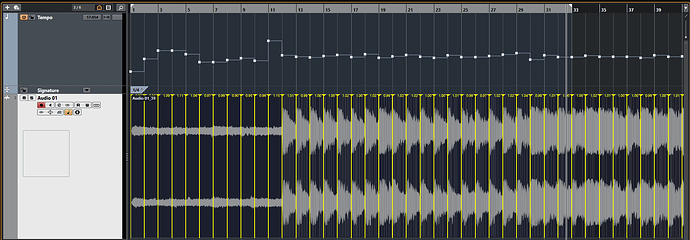Back in the olden times when I used Logic Pro X (until March of this year when I switched to Cubase Pro 12 and never looked back), I would try to do MIDI mockups by putting a song I liked at the top in an audio track, analyze the tempo, then applying it to the project.
I didn’t like many things about LPX, but the tempo detection seemed pretty good. Now, when I tried to do the same thing in Cubase, it seemed to me that the detection was always weird, like all over the place. That said, the song at the top usually is either classical or film music, which seems to me that it’s the not the easiest thing to guess the tempo, at least not for the whole piece.
Now, yesterday I was at a friend of mine with my Zoom recorder, and I asked him if he had a song in mind he wanted to play on his guitar so I could bring into Cubase and add all the other instruments using MIDI and VSTis. He came up with “Wagon Wheel” by Darius Rucker, which is country music. Hundreds of miles away from my cup of tea, but tolerable, so we recorded that. Obviously for our own amusement, I just bought a Zoom H4n Pro recorder and wanted to record a nice guitar, which he has.
Today I bought the song on iTunes, converted it to WAV (Cubase doesn’t take .m4a files) and I did the tempo detection. Well, this lovely rollercoaster ride came up:
For those of you who don’t know this song, it’s a run of the mill American country music song, the tempo is the same from start to finish, and it’s very easy to tell. Logic has a great feature that I wish Cubase had, or some plugin, which is that when you create a new project, there’s a button that says “Tap tempo” or something like that, so you listen to the song, and you click on that button at the tempo of the song, and it tells you right away what it is. Of course you being human, it doesn’t give you the exact tempo after each click, but it gives you a good idea.
So I start doing that, and it tells me that it’s between 73 and 75. I create the project, I import the song, and run the tempo detection on it. It gives me a constant tempo of 74:
And as you can see, the beats in the waveform match the tempo perfectly. So it is a 74 constant tempo. And this reminded me that when I analyzed tempo in Logic, it was much more accurate than Cubase, which always gives me some craziness like you see in the screenshot above. Sure, you can click on the offbeat button several times, and it gets close to a constant tempo, but it’s still kind of messy, when a song so basic, with a tempo so constant throughout it, should be detected as Logic did.
Now, this is not going to make me go back to Logic, Cubase is still my favorite software of all time, but I read the manual, and there’s not too much to learn about this, it’s fairly straightforward. You go to Project, Tempo Detection, it does its thing, then shows you the tempo track. If it detected something with a range that is too big, it shows you the Smooth tempo button, in this case it didn’t. And that’s about it.
In this case I’m just going to set the project to constant 74, but I keep wondering, why does Cubase always gets tempo with so many highs and lows, never a constant tempo, even in the most plain basic songs like this? Or is there a setting or something else that I’m missing?
Edit: I just discovered Cubase also has a tap tempo function, and it gives me about the same, but when I set the project to that tempo, somehow the lines don’t match with the peaks in the waveform like they do in Logic.





